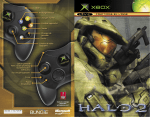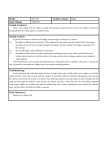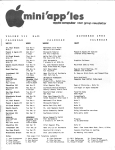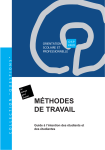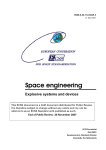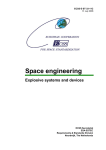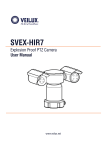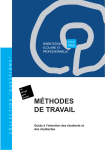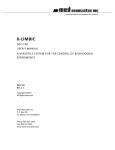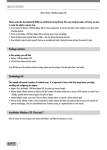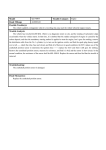Download User Manual
Transcript
ED-6 Hand-Held Explosive/Drug Materials Detection System User Guide 1 User Guide of NDR ED-6 Hand-Held Explosive/Drug Materials Detection System Catalogue 1. Forward………………………………………………………………………..…. 2. Basic parts and assembly method……………………………………………….. 2.1 Basic parts of ED-6 detector………………………….. 2.2 Assembly of ED-6 detector………………………. 2.3 Disassembly of ED-6 detector………………… 3. Operation instruction…………………………………………………………….. 3.1 The basic operation method of ED-6 detector…………… 3.1.1 How to use ED-6 detector…………………………… 3.1.2 How to obtain the information of suspicious object… 3.1.3 How to lock the object detected……………………………. 3.1.4 How to confirm the detected object locked……………… 3.1.5 Major facts affecting the performance of ED-6 detector……………………………………………….. 3.2 Detection planning…………………………………………… 3.2.1 How to select and confirm the walking route ………………... 3.2.2 How to use the handle detector to adjust the sensitivity of detectors (the magnitude of the detected materials) knob… 3.3 Detection cases of ED-6 detector…………………………. 3.3.1 Inspection of single building………………………………… 3.3.2 Inspection of more buildings……………………………… 3.3.3 Inspection of an open area………………………… ………. 3.3.4 Inspection of streets, blocks, and vehicles……………… 3.3.5 Inspection of container ports………………… ………… .3.6 Inspection of parking lots………………………… …. 4. Training guide…………………………………………………………………….. 4.1 Professional training……………………………………………………... 4.1.1 Training for basic operation……………………………………….. 4.1.2 On-site detection training………………………………………… 4.2 Self training……………………………………………………………….. 4.3 Practice and improvement……………………………………………… 5. Conclusion remark………………………………………………………………. 2 User Guide of NDR ED-6 Hand-Held Explosive/Drug Materials Detection System 1. Foreword Anti-terrorism becomes an important topic throughout the world since “September 11” Attack. The rampancy of cases of criminally caused explosion and terrorist activities makes terrorists become the target to contend with by the security departments of all the countries. By now, the recognition of “security and prevention” of the international community has been promoted to a brand new level. All the sectors throughout the world have strengthened their routine security work. Under such background, the demands for detecting devices effectively detecting suspicious articles are increasing day by day. ED-6 is a new generation of internationally advanced remote non-contact explosive and drug detector successfully developed by us in early 2009 through many years of efforts on the basis of integrating the technologies of various international explosive and drug detecting equipment and the actual application status; the detection principle of this product is based on the unique molecule structure vibration spectrum of explosives and drugs; it can even authenticate the detected material as exact as that of finger prints. It is featured for that it can be upgraded as new type of explosive comes into being, enabling apprehending work to be continued. At the same time, it can divide remaining materials detected from certain amount of detected materials, dramatically promoted the detection accuracy. l Main features of ED-6 Hand-Held Explosive/Drug Materials Detection System (1) Non-contact, remote detecting: when the ground has no obstruction the max distance can be 1000 m. In good condition the distance can be about 5000m on plane, 30m under water, and 10m under ground. (2) Accurate location lock: The detected object can be locked in a range of 1~4 cubic meters. (3) Able to detect many kinds of materials simultaneously: Maximally 8 types of materials can be detected at the same time. (4) Able to set the magnitude of detected material: it can exclude the traces or interference of small amount of detected materials that may have on the 3 User Guide of NDR ED-6 Hand-Held Explosive/Drug Materials Detection System detection. (5) Only detect materials of single direction: to exclude the interference of detected materials of relative directions. (6) Strong anti-environment interference performance: The detector will not be affected by any barrier such as liquid, metals, buildings etc, or tough environment such as wind, dust, weathers etc. (7) Wide application rang: Can be used by police, customs, airport safety inspection, anti-terrorism armed forces etc. (8) Accurate internal angle sensor: can detect whether the direction indication panel is in the horizontal state, with LED direction indicator light and voice prompt. If the operator does correct operation the LED direction indicator light is off and the voice prompt says “YES”. Otherwise, the voice prompt says “NO” and the LED direction indicator light keeps flashing in the direction of deviation. However a simple training is able to help the operator handles it properly. (Practice is necessary in order to improve the accuracy of the detection) (9) Convenient to carry: The detector is composed of the indication panel and the handle. Parts assembly time is short (less than 10 second), and is convenient to carry. l Materials that can be detected by Explosive/Drug Materials Detection System ED-6 Hand-Held (1) Explosives: Military explosive such as TNT, DNT, Tetry, PETN, HMX etc; Civilian use or self produced gun powder, NG dynamite, RDX/Hexogen/Octagon Black Powder, Ammunition & Propellants low explosive, Short gun bullets, Old weapons, Firecrackers, Fireworks, Plastic explosives – C4, C1, PE4, Semtex, etc. (2) Drugs: Amphetamine, Cocaine, Ecstasy/MDMA, Heroine, Marijuana, LSD/Ketamine, etc. 4 User Guide of NDR ED-6 Hand-Held Explosive/Drug Materials Detection System l Use of this manual This manual is composed of parts introduction, assembly, operation and use, detecting method, cautions, trouble shooting and the general basic information of technical operation of ED-6 Hand-Held Explosive/Drug Materials Detection System. The purpose of this manual is to provide the user of ED-6 Hand-Held Explosive/Drug Materials Detection System with support and guide reference. Operators should exercise repetitively with the method taught by the trainer until master how to use it completely; operators who have not got skilled with the operation should not train other operator; reading of this manual should not take the place of operation training for those who are not trained for operation. As technical improvement and experience summarization go on, we reserve the right to update and supplement this manual with contents without notification to the user. Users should keep contact with the local distributor to acquire the latest information and timely technical support. Note: 1. Please read this manual carefully before using ED-6 Hand-Held Explosive/Drug Materials Detection System. 2. Reading of this manual should not take the place of operation training for ED-6 Hand-Held Explosive/Drug Materials Detection System. 5 User Guide of NDR ED-6 Hand-Held Explosive/Drug Materials Detection System Note: 1. Subjected to the technology level today, ED-6 Hand-Held Explosive/Drug Materials Detection System must be hand carried by the operator, and be used in a slow walking mode. Do not try to place the indication panel to other tool for use. 2. Subjected to the accuracy of the direction pointed by the pointer and that the pointer can not be locked automatically, the suspicious object pointed by this detector is within a range of about 4 cubic meters, which may expand as the distance gets farther. By now, this detector can not precisely locate the detected material. Therefore, manual or other search methods should be applied when suspicious articles are detected. 6 User Guide of NDR ED-6 Hand-Held Explosive/Drug Materials Detection System 2. Basic parts and assembly method 2.1 Basic parts of ED-6 detector 1. Direction indication panel 2. Handle 3. Information card for detected materials 4. Spare lithium battery 5. Lithium battery charger 6. User guide 7. Portable instrument case 8 Storage clip for information card and Detector wiper 2.2 Assembly of ED-6 detector Step 1 Open the portable instrument case. Step 2 Take out the direction indication panel from the case and check whether the pointer in the direction indication panel can move freely to the right and left or not. 7 User Guide of NDR ED-6 Hand-Held Explosive/Drug Materials Detection System Step 3 Take out the handle from the case. There is a sliding closure at the side of the handle, open it to load the lithium batteries, and insert the information card in the slot. Close the sliding closure. . Step 4 1. A sound of “click” will be heard when the handle is inserted into the bottom slot of the indication panel; try to slip the handle detector out from the bottom slot of the indication panel to test the tightness of the installation. The handle must be ensured not to slip out from the bottom slot of the 8 User Guide of NDR ED-6 Hand-Held Explosive/Drug Materials Detection System indication panel when the clamping piece of the handle is not pressed. Note: 1. If the to-be-detected material is confirmed before hand, insert the information card of this material directly. Maximally 8 information cards can be inserted into the system at one time; that is to say, up to 8 types of suspicious materials can be detected at the same time. To confirm the specific material type detected, the cards inserted into the machine should be removed one by one, thus to determine which kind of material is detected with exclusive method. At the same time, pay attention that more than one material might be contained for certain types of explosives. 2. Pay attention to the direction when inserting the information cards. 9 User Guide of NDR ED-6 Hand-Held Explosive/Drug Materials Detection System 2.3 Disassembly of ED-6 detector When disassembling the detector, operate in the order described in part 2.2 in a reverse way. Note: 1. Charge the lithium battery every time after usage. At the same time, pull out the information cards from the system and place them into the card clip. 2. Before placing all the parts into the instrument case, clean the parts carefully with the wiper. 10 User Guide of NDR ED-6 Hand-Held Explosive/Drug Materials Detection System 3. Operation instruction 3.1 The basic operation method of ED-6 detector 3.1.1 How to use ED-6 detector l After assembling ED-6 detector in the order described in part 2.2, turn on the switch. l Insert the earphone plug in the headphone jack which is in the bottom of handle. l The screen can show the horizontality. When the deflected angle of direction indication panel is more than the set angle, the four LED lights will show the direction of deviation. At the same time, the voice prompt in the headphone will say “NO”. When the deflected angle of the direction indication panel is less than the set angle, the four LED light will turn off and the voice prompt in the headphone will say “YES”. l the operator can use the instrument in a standing and walking status, with the hand firmly holding the handle of the detector, the forearm and the back arm forming an angle between 60°~90° degrees, elbow towards the waist, eyes attending to the pointer of the direction indication panel, keeping the direction indication panel in a horizontal state. Note: 1. Do not place the direction indication panel of the detector right in front of the chest; otherwise, the receiving accuracy of the detecting signal will be affected. 2. In the process of detecting (walking or standing), keep attending to the pointer of the detector, for which there are two important purposes, one is that pointer shaking resulted from body movements can be reduced to the most; the second is that it can avoid hypothesis of suspicious object location. The direction and orientation pointed by the indication panel pointer can be observed 11 only after the object information receiving is confirmed. User Guide of NDR ED-6 Hand-Held Explosive/Drug Materials Detection System l The operator can hold the detector handle with either left hand or right hand. Gloves can be worn in cold weather. Before detecting, softly shake direction indicator to the left and right, ensure the pointer of the indicator can freely rotate to the left and right. (The swing should be more than 15 times.) l Before starting to walk, ensure the direction indication panel of the detector is horizontal and the pointer points right forward (In the right side between -5°~-10°). Note: Before detecting formally, the operator should hold the detector properly with hand and walk to and fro for a dozen of steps to prepare him and the detector for entering the normal work mode. When starting to detect in a new environment, at least 5 minutes are needed for the operator to prepare the detector well until starting work formally. l If the detected is not on ground (an elevated location 2m above the ground or underground), it’s better for the operator to draw a simple map on the portable pad to record the suspicious location in the process of detection. Note: 1. The pointer of the ED-6 detector will not vibrate and generate any harmful radials except that the pointer will sway when receiving signals. 2. The operator should remain in a completely relaxed state, keep a normal slow walking or standing posture; it is forbidden to manually or unconsciously shake the detector handle in a nervous state. If the operator can not be relaxed completely, the detection result may be wrong. 12 User Guide of NDR ED-6 Hand-Held Explosive/Drug Materials Detection System 3.1.2 How to obtain the information of suspicious object Step 1 By following the above method to handle the detector, stand at the start point of the route, keep naturally relaxed, with eyes attending to the pointer of the indication panel. Note: Before starting to walk, ensure to observe the route along which to walk to avoid barriers affecting the normal walking. The best way is that the operator is accompanied by another staff and protected by him. However, the normal detecting operation of the operator should not be affected. Step 2 Tilt the indication panel forward for 10°, shake the indicator to the left and right to have the pointer sway several times, ensure the pointer can move to the left and right freely more than 15 times. Then hold the indication panel horizontally, with eyes attending to the pointer, make the pointer in the right side between 5°~10°position. After the pointer is confirmed to be in position, go on with the next step. Step 3 Fix eyes on the pointer of the direction indication panel all the way, walk along the route planned. In the process of walking, keep the direction indication panel stable. Observing that the four LED light are not on and the voice prompt is “YES”, the detector shall then be considered qualified. l During walking, if the swaying scope of the pointer to the left and right is not over ±10°, the sway of the pointer can be neglected and continue to walk along. l If the pointer turns to left in a relatively fast speed of more than 60°, stop walking immediately and stand still, keep the direction indication panel stable (The LED light is not flashing), eyes attending to the movement of the pointer. If the pointer turns to 90° in the left, tilt the direction indication panel forward to make the pointer return to position in the right side of 5°~10°; at the same time, 13 User Guide of NDR ED-6 Hand-Held Explosive/Drug Materials Detection System observe and record the location and environment around where you are standing. Then continue to walk along. Note: 1. Now, what the operator needs to do is to remember the location where he stops, no need to make any guess. 2. In most cases, if the pointer moves to the 90° or over 90° direction rapidly instead of gradually, the signal is normally false. In this case, the LED light for tilting direction will be flashing and voice prompt is “NO”, which is convenience for the operator to identify the authenticity of the signal. Step 4 When walking to the end point of the planned route, turn back and repeat from step one to three, and walk back to the starting point. After returning to the original starting point: (1) If no suspicious object signals are detected for this to-and-fro detection (that is the pointer of the direction indication panel never moved to the left for over +60°), start up to 4 times of to-and-fro detection according to the description from step one to three after moments of rest. (2) If one or more suspicious object signals are detected during this time (that is the pointer of the direction indication panel moved to the left for over +60°), start 1-2 times of to-and-fro detection according to the description from step one to three after moments of rest. Step 5 Through the detection operations in above steps, if no suspicious object signals are detected in up to five times of to-and-fro detection, it can be preliminarily judged as no suspicious object is found in the inspected range. If suspicious object signals are found in two times of to-and-fro detection, lock the object detected as described in part “3.1.3 How to lock the object detected.” 14 User Guide of NDR ED-6 Hand-Held Explosive/Drug Materials Detection System Note: 1. The correctness of the detection result is related to many facts, thus only preliminary judgment can be made here. 2. If further confirmation is needed, change another person to detect or change the detection level, or adjust the walking speed to confirm. 3.1.3 How to lock the object detected Method 1 When suspicious object signals are detected (the pointer moves for over 60°, and continues to turn backwards until exceeding 90°after stopping), set the pointer of the direction indication panel to the right side of -5°~-10°, retreat back for ten to fifteen steps; then continue to walk forwards slowly and stop when any suspicious object signal is detected. Repeat above operation until the pointer of the direction indication panel points to the left of the location where you standing for +90°; after a slightly shaking under non-moving status, the direction to which the pointer points is probably the direction where the target is. In this way, the suspicious object is locked in one direction, however not yet be confirmed where the specific location is. The same method as described above should be used again in the direction perpendicular to the direction above. Then the crossover point of both directions is the actual location of the detected. Method 2 When it is permitted geographically and suspicious object signal is detected (the pointer moves over +60°, and continues to move forwards to over 90°after you have stopped), the operator can turn in the direction pointed by the pointer, walking out a spiral circle gradually close to the center. In this way, the suspicious object can be locked in a rapid and accurate speed. 15 User Guide of NDR ED-6 Hand-Held Explosive/Drug Materials Detection System Note: 1. When this method is used to lock the detected object, you will find that it will move back each time when moving to the location of the object until the pointer of the direction panel pointing to +90° where you are standing. The reason is that when you are shifting to the object with the detector, the signal received is the strongest; besides, the interaction force between the detector and the object is maximized in the final detected range, so the detector will lead you to lock the object gradually. 2. Training and repeated practice are needed to lock the detected object in this way; besides, it is also related to facts such as level selection, the amount of the detected material, and distance etc. The detection should be judged by the operator on the basis of actual detection situation and the practical experience in an integrated way. 3. When the landform is complex, make proper record. If it’s impossible to detect in two directions that are perpendicular to each other, two directions that are approximately perpendicular to each other can be applied. The important point is to make record properly or draw a plane graph on paper, find out the crossover point of the two directions indicated by the detector. 3.1.4 How to confirm the detected object locked Step 1 The operator should relax himself completely, and restore the pointer to position in the right side between -5~-10°. Walk in a relatively fast speed by the side of the locked object. After pointer deflection occurs, gradually retreat until the pointer points to +90°. If it is consistent to the direction locked just now, it can be basically confirmed that the direction locked is the location direction of the object. Step 2 If it is possible, the operator should approach to the location of the object, and walk with the detector held along a line within 1 meter away from the 16 User Guide of NDR ED-6 Hand-Held Explosive/Drug Materials Detection System object; on the location of the object, the pointer will turn back quickly to left point at the object. Now the location of the object can be determined. Note: 1. Normally on the plane surface, the object should be within the range of 1-4 cubic meters pointed by the pointer 2. For the concerns of parallax and the operator’s judgment, the inspection range for manual search can be properly increased. 3.1.5 Major facts affecting the performance of ED-6 detector The major facts affecting the detection effect of the detector include: l The skill level of the operator. The operator is thus required to accept proper training, and summarize the practical experience of success and failure repetitively. l Conscious and unconscious guess of and suppose of the location of the object before and during the detection. After the operator is predominated by this sense, the actual detection result of the detector will be greatly affected. Note: 1. You should believe ED-6 detector, do not guess just on your own. 2. For the suspicious signal occurs during the detection, do not guess or judge ideologically by yourself; have the detector judge whether there is object signal. l The psychological and physical state of the operator. If the operator is 17 User Guide of NDR ED-6 Hand-Held Explosive/Drug Materials Detection System too exhausted or nervous, the detection result will also be affected dramatically. 1. Before starting the detection work formally, adjust yourself psychologically, keep in calm and get rid of any distracting thought; do not be affected by the sound or other factors in the environment around. 2. Never test repeatedly and work in an exhausted state for detection. Normally, a rough judgment can be made after three times of repetition on the assigned route. If there are too many suspicious signals and the object can not be locked at the time, have a rest for five to ten minutes to adjust your state, considering either to change the detection level or change the detection route. At this moment, impatience is not allowed. The time for each practical detection should be controlled within 30 min. regardless that whether the suspicious object is confirmed or not, you should have a rest from 5-10 min. Take down the detector from your body when having a rest. 3. The formal detection work should be carried out by a group composed of 2-3 persons, in this way the persons can work alternatively to reduce tiredness; on the other hand, the situation occurring can be analyzed commonly. Note: 1. When two or three persons working at the same time to detect the fixed environment, the previous operator should not tell the succeeding one his detection result, thus to avoid affecting the detection result of the successor. The correct way is that after the detection work is completed, all the three gather together to discuss the detection result. 2. No matter how the result is, do not confirm the location of the object just with the opinions of the three persons. The result should 18 instead of human. be determined by the detector User Guide of NDR ED-6 Hand-Held Explosive/Drug Materials Detection System l The operator’s understanding of the detector Each ED-6 detector produced by us is aligned and tested in a repetitive way; the performance specifications are the same. However, just as each automobile has its own characteristics, each ED-6 detector has some difference that can not be measured, for which the operator should master and understand through practice. l Influence of the surrounding environment The objects within the range of 1000m in radius around the operator will act on the detector in different levels, thus to affect the detection result. The most effective methods to get rid of the interference are: (1) Change the level of the handle detector. (2) Change the walking speed for detection. (3) Reduce the quantity of the information cards on the main machine; the best way is to leave the only card of the material to be detected. l If the object is on ground (an elevated location 2m above the ground or underground), it’s better for the operator to draw a simple map on the portable pad to record the suspicious location in the process of detection. 3.2 Detection planning Detection planning refers to that before starting the detection formally, make an on-spot investigation of the site environment and preliminarily set down the detection route, detection method; and confirm the countermeasures for problems that may occur. Detection planning is normally divided into the following steps: Step 1 Investigation on the on-spot environment. When investigating, besides visually observing the surrounding environment, you should also walk 19 User Guide of NDR ED-6 Hand-Held Explosive/Drug Materials Detection System around. If the range is relatively big and complex geographically; or the range to be detected has relatively more buildings or other on-ground constructions, draft a map on the record pad. Step 2 Preliminarily confirm the walking route for the detection and walk for one time actually. Step 3 Plan the detection preliminarily, such as detection level selection, walking speed, and how many information cards to be inserted etc. Step 4 Judge what problem may be encountered preliminarily, and plan the countermeasures roughly. Note: 1. For group work, should discuss the detection plan before work, implement the related measures after summarizing the opinions of all the parties, and confirm the next work division, such as who works first, who works as the leader and who makes record. 2. For single-person operation, it’s better to find other people for help, such as recording and guiding. 3. Detection planning is of great significance for promoting detection efficiency and accuracy, which should be treated seriously and continuously summarized and perfected. 3.2.1 How to select and confirm the walking route The following principles should be followed in selecting and confirming the detection route: Principle 1 The selected detecting route should cover the area to be detected in a good way. Principle 2 The signal point found on the selected detecting route can be conveniently marked or the object direction should be conveniently observed. Principle 3 There should be relatively less barriers on the selected detecting route, not affecting the operator walking. If the operator has to watch on the 20 User Guide of NDR ED-6 Hand-Held Explosive/Drug Materials Detection System ground in the process of walking, the detection accuracy will be affected to a large extent. 3.2.2 How to use the handle detector to adjust the sensitivity of detectors (the magnitude of the detected materials) knob The handle detector has a knob to adjust the sensitivity of the detector (the magnitude of the detected materials). When twisting the knob clockwise, the operator can reduce the sensitivity of the detectors so as to increase the magnitude of the detected materials. Instead, when twisting the knob counter clockwise the operator not only can lower the sensitivity of the detector, but also reduce the magnitude of the detected materials. There is a tick mark from 0~25 interior, for pointing out the position of the knob. On the testing site, the operators choose the magnitude of the detected materials reasonably,which can exclude trace and the interference of trace substances to the detection results. For the close (Placed close to the walls) materials to be detected, need to adjust the knob carefully, thus to improve the precision of the position for the detected materials. 3.3 Detection cases of ED-6 detector 3.3.1 Inspection of single building Step 1 Walk around the building; mark out an outline drawing. Step 2 Inspect the surrounding area of the building with straight-line inspection method; do not attend to any suspicious reaction of the detector pointer to the surrounding of the building. Step 3 The location of any suspicious reaction point should be recorded or marked on the draft map. Step 4 Exclude the safe area after several times of detection; detect the suspicious area again. Step 5 After confirming the suspicious area, search by entering the building. 21 User Guide of NDR ED-6 Hand-Held Explosive/Drug Materials Detection System Note: 1. The suspicious object may be concealed under the floor, in wall holes, on the ceiling, or on underground floor. After carrying out manual inspection according to the detection result of detector, detect with the detector once again. When detecting again, pay attention to the influence of the remained material left around. Twist the knob to exclude the influence by remained material. 2. If there is moving object in the room, such as an armed person, it will be hard for the detector to point out the correct location. IN this case, the operator can stand still, to see whether the detector pointer will move along with the moving object; when the pointer is found to be moving along with the moving object, check whether there is object (material) to be detected on the moving object. 3.3.2 Inspection of more buildings Step 1 Walk out an arc around the outside of the buildings first (may be repeated for several times), observe the pointer’s pointing status, then preliminarily determine which area should be detected as a key one. Step 2 Walk around the building; mark out an outline drawing. Step 3 Inspect the surrounding area of the building with straight-line inspection method; do not attend to any suspicious reaction of the detector pointer to the surrounding of the building. The location of any suspicious reaction point should be recorded or marked on the draft map. Step 4 Exclude the safe area after several times of detection; detect the suspicious area again. Step 5 After confirming the suspicious area, search by entering the building. 22 User Guide of NDR ED-6 Hand-Held Explosive/Drug Materials Detection System Note: 1. If possible, detect at the location about 10m away from the building. 2. If the area to be searched is relatively big, a plane drawing should be worked out first for the recording of any suspicious point found in the detection. 3. Do not work when exhausted. Have a rest after detecting for certain time (20-30min). Analyze the suspicious point found and exclude safe area; narrow down the detection range. Do not be impatient; keep a calm mind. 3.3.3 Inspection of an open area When inspecting a large community or in a large area with the detector, detection plan should be made first. The inspection method should be the same as that of building surrounding detection in case that the general viewing of the first phase is completed by a plane or a helicopter. In this way, it may be soon to determine the key inspection area; however, the accuracy in this way is not high. If possible, start to search from the ground directly; the specific steps are as follows: Step 1 Draw a map or use land map and mark first, see how to divide the surrounding area into sub-areas of 50 square meters each, mark out those that are likely to be concealed or missed out Step 2 Subdivide the areas, the inspection work can be assigned to several work groups, carrying out detection and inspection of each subdivided area. Step 3 The inspected sub-area should be marked out, make it clear to other work group. Step 4 At the same time, a separate group can carry out inspection to the points that are likely to be concealed or missed out in the open area. And make it known to all other groups. Step 5 Mark out the location of the suspicious with the flag. Step 6 Collect the inspection results of each group, exclude safe areas, re-inspect suspicious areas. 23 User Guide of NDR ED-6 Hand-Held Explosive/Drug Materials Detection System Step 7 Carry out detection inspection to the key areas according to the operation method described above until suspicious objects are found or the safety of the area is confirmed. Note: 1. The to-be-detected materials may be concealed underground or in plants 2. Once the inspection is completed and the suspicious materials are found; inspect once again to prevent missing out; preventing the antagonist using the detected materials as an enticement to mislead the inspection to and end. 3.3.4 Inspection of streets, blocks, and vehicles The best way to inspect streets and blocks is to reduce vehicle traffic to the most or to hold up the traffic. When there are many alleyways, try to narrow down to one alleyway or two worst alleyways. Before setting up temporary barricades, inspect the surrounding first. Then carry out detection inspection with the method described above. Step 1 Inspect the surrounding of the area set up with barricades. Step 2 Inspect initially before setting up parking points or stopping the vehicle, if there is any suspicion, detain the vehicle and send it to the secondary area for further inspection. Step 3 Release the vehicle or carry out further investigation to it after the inspection of the vehicle in the secondary area is completed. Step 4 Have the passengers get off, inspect the vehicle and the passengers. If no suspicious materials are found on in the vehicle, passengers or suspects may carry suspicious materials; or there is someone has taken drugs with suspicious materials. However, if the signal of the detector continues to point to the vehicle, carry out the following deployment: l For cars, unload the entire luggage, check the car and all the luggage 24 User Guide of NDR ED-6 Hand-Held Explosive/Drug Materials Detection System contents. If the signal continues to point at the car, we may further confirm the car with trace detector or police dog before detaining the car. l For trucks, we should ensure to start to inspect from small parts; further detect the confirmed cargos with other instrument before unloading the cargos. Remember to search each cargo piece after they are unloaded; then inspect the truck again. Besides searching the cargos, check whether there is new marks or false interlayer. For successful search, understanding of the vehicle is also very important. l For buses, confirm the locations of suspicious traces, have the passengers of such location get off. Search the suspicious passenger and his seat surrounding. The suspicious location may be with the luggage or in the false interlayer of the bus. Find the suspicious points with the detector; search the bus once again quickly with police dog. Remember, police dog will not search those who have taken drugs. Note: If it is impossible to set up barricade for there are too many vehicles, adopt S shaped road to have the vehicles pass slowly, set the detector at the S point. 3.3.5 Inspection of container ports For container port inspection, the safety of the operator should be considered first for that container ports are mostly very busy. Inspection of stacked containers will be very dangerous. The operator should be accompanied by the professional personnel from the container port and adopt sufficient safety protection measures. Or just inspect when the container is in and out of the port. The basic steps to inspect container ports are as follows: Step 1 Subdivide the port into many small areas. Step 2 Inspect all the containers; however, if the containers are stacked in three 25 User Guide of NDR ED-6 Hand-Held Explosive/Drug Materials Detection System layers or even more, the inspection will be hard to succeed. The best way is to stack all the suspicious containers together and search with a detector; time can be saved in this way. Step 3 Many means can be adopted to confirm whether there is suspicious material in the container. Open the container to inspect when the object is basically confirmed. 3.3.6 Inspection of parking lots The inspection principle of parking lots is the same as that of the inspection of other cases. Step 1 Work out a map by walking around the parking lot. Step 2 Subdivide the parking lot into small pieces when necessary. Step 3 Lock the suspicious object to one to two vehicles. Step 4 Confirm the locked object. Note: 1. The biggest problem for the final confirmation of parking lot inspection is that the distance to the object vehicle may be very near. Now pay attention that the pointer may “push back”. 2. Suspicious materials may be concealed under the vehicle or at the top of it. 3. If the suspicious vehicles can move, have them stop together or part them to some distance, which is helpful to confirm the specific object vehicle. 26 User Guide of NDR ED-6 Hand-Held Explosive/Drug Materials Detection System 4. Training guide 4.1 Professional training 4.1.1 Training for basic operation Phase 1: training for holding the direction indication panel horizontally Do not install the handle and do not load the lithium battery and information card, hold the detector handle to carry the direction indication panel. Then walk to and fro until you are walking in a relaxed and natural state. Ensure the pointer of the direction indication panel is within a range of -5~-10°, ±10°in the right side. Then put the lithium battery in, but do not insert information card. Exercise as above mentioned until you are walking in a relaxed and natural state. Ensure the pointer of the direction indication panel is within a range of -5~-10°, ±10°in the right side Note: 1. Exercise both with left and right hand. 2. A good operator is not trained within one day. Be patient and good-tempered. 3. The trainee should experience carefully and experiment repeatedly under the instruction of the trainer until the feel is good enough. Phase 2: Perception exercise to the detected signal When the location of the object to be detected is known, use different search method to find out how the detector receives the signal of the object to be detected. 27 User Guide of NDR ED-6 Hand-Held Explosive/Drug Materials Detection System In this phase, the object to be detected can be placed by the trainee or other people, the trainee thoroughly know the exact location of the object. The trainee can adopt different methods for understanding how the detector receives the signal of the object to be detected. In this phase, the trainee should clearly percept in what state does the detector receive the signal of the object to be detected. Feel the walk speed and pace, and what’s the influence upon signal receiving of the detector and the reaction speed of the pointer by factors such as the size of the object to be detected and the distance to the object to be detected; at the same time, feel the difference between “false signal” and true signal and why there is “false signal”; how to identify and eliminate “false signal”. Phase 3: Training for screening the objects to be deleted Use many possible objects, among which there is only one that should be detected. Place them in an environment. The operator can know the location of each possible object. Use different search mode to feel how the detector receives the signal of the object to be detected. The purpose of training in this phase is to learn how to conquer the consciousness of guess to the possible locations, thus to enable the operator not to be affected by pre-hypothesis or prefixed object location or the location of “false signal”. The trainee is thus required not to make any hypothesis or guess before hand although he knows several possible object locations; instead, he should let the detector to guide and judge as a whole. 28 User Guide of NDR ED-6 Hand-Held Explosive/Drug Materials Detection System Note: 1. In training, it will be found that when the operator doubt certain possible object consciously or unconsciously, the doubted object is likely to be detected although the doubted object sometimes is not a really suspicious object to be detected. In such circumstance, the real suspicious object will “escape unpunished”. It is thus clear that how serious the hypothesis and suppose consciousness of the operator will affect the detection result. The operator must train himself to be capable of resisting the influence of his own hypothesis and suppose. 2. In the training of the phase, do not make any suppose or hypothesis to see whether there is possible object and then detect. The training purpose in this way will not be reached. The trainee should confirm the object first. If wrong, replace the object and redetect. Phase 4: Training for strange detection of the object to be detected Detect when the orientation of the object to be detected is completely unknown. Here, the training can be divided into two modes, one is that there is really to-be-detected object placed in the detection environment, which is to be searched by the operator; the other is there is no to-be-detected object, which is to be searched by the operator. For the latter, the truth should not be told to the operator. 4.1.2 On-site detection training Take part in the on-site detection training under the guide of the trainer. 29 User Guide of NDR ED-6 Hand-Held Explosive/Drug Materials Detection System 4.2 Self training The operator should design some scenes on his own according to his study in the training process to have self-training. The purpose of self–training is for the perception of true signals and false signals and the judgment method. 4.3 Practice and improvement After having accepted the training courses, the operator should keep summarizing and improving in the following practice; carefully record and analyze the problems occur in various practical work. For uncertain or repetitive phenomena, notify the local distributor and trainer timely. 30 User Guide of NDR ED-6 Hand-Held Explosive/Drug Materials Detection System 5. Conclusion remark Practice makes perfect. Being brave in practice and good summarization is the key to improving detection efficiency and accuracy. Under the current detecting technology level, the operation level and ability of the operator is critical to suspicious object detection in an accurate and fast way. Therefore, continuous practice and summarization is quite important. You practice experience may become the important original materials for the next revision of this manual. Telling us your perception, understanding, and discovery will be greatly appreciated. Thanks! 31































